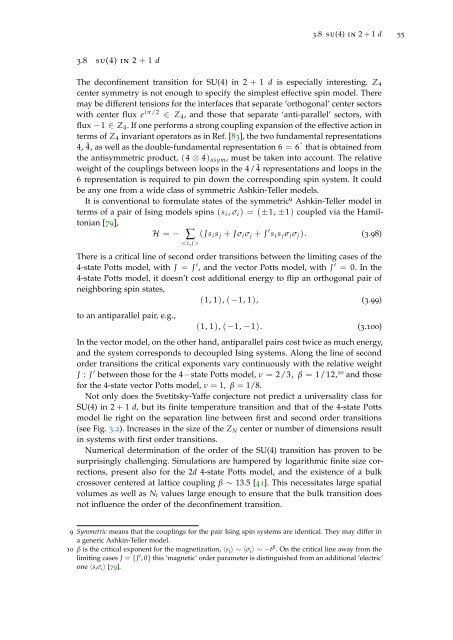Topology, symmetry, and phase transitions in lattice gauge ... - tuprints
Topology, symmetry, and phase transitions in lattice gauge ... - tuprints
Topology, symmetry, and phase transitions in lattice gauge ... - tuprints
You also want an ePaper? Increase the reach of your titles
YUMPU automatically turns print PDFs into web optimized ePapers that Google loves.
3.8 su(4) <strong>in</strong> 2 + 1 d 55<br />
3.8 su(4) <strong>in</strong> 2 + 1 d<br />
The deconf<strong>in</strong>ement transition for SU(4) <strong>in</strong> 2 + 1 d is especially <strong>in</strong>terest<strong>in</strong>g. Z 4<br />
center <strong>symmetry</strong> is not enough to specify the simplest effective sp<strong>in</strong> model. There<br />
may be different tensions for the <strong>in</strong>terfaces that separate ‘orthogonal’ center sectors<br />
with center flux eiπ /2<br />
∈ Z 4 , <strong>and</strong> those that separate ‘anti-parallel’ sectors, with<br />
flux −1 ∈ Z 4 . If one performs a strong coupl<strong>in</strong>g expansion of the effective action <strong>in</strong><br />
terms of Z 4 <strong>in</strong>variant operators as <strong>in</strong> Ref. [83], the two fundamental representations<br />
4, ¯4, as well as the double-fundamental representation 6 = 6 ∗ that is obta<strong>in</strong>ed from<br />
the antisymmetric product, (4 ⊗ 4) asym , must be taken <strong>in</strong>to account. The relative<br />
weight of the coupl<strong>in</strong>gs between loops <strong>in</strong> the 4/ ¯4 representations <strong>and</strong> loops <strong>in</strong> the<br />
6 representation is required to p<strong>in</strong> down the correspond<strong>in</strong>g sp<strong>in</strong> system. It could<br />
be any one from a wide class of symmetric Ashk<strong>in</strong>-Teller models.<br />
It is conventional to formulate states of the symmetric 9 Ashk<strong>in</strong>-Teller model <strong>in</strong><br />
terms of a pair of Is<strong>in</strong>g models sp<strong>in</strong>s (s i , σ i ) = (±1, ±1) coupled via the Hamiltonian<br />
[79],<br />
H = − ∑ ( J s i s j + J σ i σ j + J ′ s i s j σ i σ j ). (3.98)<br />
<br />
There is a critical l<strong>in</strong>e of second order <strong>transitions</strong> between the limit<strong>in</strong>g cases of the<br />
4-state Potts model, with J = J ′ , <strong>and</strong> the vector Potts model, with J ′ = 0. In the<br />
4-state Potts model, it doesn’t cost additional energy to flip an orthogonal pair of<br />
neighbor<strong>in</strong>g sp<strong>in</strong> states,<br />
(1, 1), (−1, 1), (3.99)<br />
to an antiparallel pair, e.g.,<br />
(1, 1), (−1, −1). (3.100)<br />
In the vector model, on the other h<strong>and</strong>, antiparallel pairs cost twice as much energy,<br />
<strong>and</strong> the system corresponds to decoupled Is<strong>in</strong>g systems. Along the l<strong>in</strong>e of second<br />
order <strong>transitions</strong> the critical exponents vary cont<strong>in</strong>uously with the relative weight<br />
J : J ′ between those for the 4−state Potts model, ν = 2/3, β = 1/12, 10 <strong>and</strong> those<br />
for the 4-state vector Potts model, ν = 1, β = 1/8.<br />
Not only does the Svetitsky-Yaffe conjecture not predict a universality class for<br />
SU(4) <strong>in</strong> 2 + 1 d, but its f<strong>in</strong>ite temperature transition <strong>and</strong> that of the 4-state Potts<br />
model lie right on the separation l<strong>in</strong>e between first <strong>and</strong> second order <strong>transitions</strong><br />
(see Fig. 3.2). Increases <strong>in</strong> the size of the Z N center or number of dimensions result<br />
<strong>in</strong> systems with first order <strong>transitions</strong>.<br />
Numerical determ<strong>in</strong>ation of the order of the SU(4) transition has proven to be<br />
surpris<strong>in</strong>gly challeng<strong>in</strong>g. Simulations are hampered by logarithmic f<strong>in</strong>ite size corrections,<br />
present also for the 2d 4-state Potts model, <strong>and</strong> the existence of a bulk<br />
crossover centered at <strong>lattice</strong> coupl<strong>in</strong>g β ∼ 13.5 [41]. This necessitates large spatial<br />
volumes as well as N t values large enough to ensure that the bulk transition does<br />
not <strong>in</strong>fluence the order of the deconf<strong>in</strong>ement transition.<br />
9 Symmetric means that the coupl<strong>in</strong>gs for the pair Is<strong>in</strong>g sp<strong>in</strong> systems are identical. They may differ <strong>in</strong><br />
a generic Ashk<strong>in</strong>-Teller model.<br />
10 β is the critical exponent for the magnetization, 〈s i 〉 ∼ 〈σ i 〉 ∼ −t β . On the critical l<strong>in</strong>e away from the<br />
limit<strong>in</strong>g cases J = {J ′ , 0} this ‘magnetic’ order parameter is dist<strong>in</strong>guished from an additional ‘electric’<br />
one 〈s i σ i 〉 [79].
















